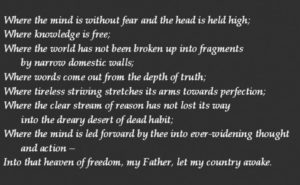We all know that he created a school for children and called it Shanti Niketan.
But the important questions are: why was his song chosen as the anthem when there were equally wonderful poems being written at that time?
And why did he create Shanti Niketan?
The answer to both these questions is the same.
 Rabindranath Tagore wrote the Gitanajali in Bengali. The great Irish poet W.B Yates heard about them and asked for a translation. Tagore wrote them in English. The Gitanjali took the western world by storm and Tagore was conferred the Nobel prize. Soon after, Tagore was also chosen to be knighted by the Monarch of Great Britain. He was to be called Sir Rabindranath Tagore. It is one of the highest recognition for work done in any field.
Rabindranath Tagore wrote the Gitanajali in Bengali. The great Irish poet W.B Yates heard about them and asked for a translation. Tagore wrote them in English. The Gitanjali took the western world by storm and Tagore was conferred the Nobel prize. Soon after, Tagore was also chosen to be knighted by the Monarch of Great Britain. He was to be called Sir Rabindranath Tagore. It is one of the highest recognition for work done in any field.
The British were ruling India at that time. There was political unrest with Indians asking for autonomy. The Rowlatt Act passed by the British ruled that Indians should not hold meetings or gather in large groups or discuss the political situation in the country. Despite the act, at Jalianwala bagh, in Punjab, a rally was held.
General O’Dyer took a suomoto decision and opened fire at the crowd without warning. Hundreds of people, including women and children were killed in the firing. The news shocked the world. The British government was horrified by O’Dyer’s action.
The nation mourned the action. Tagore did not consider it a single unconnected event but as an attitude of the ruling minority. He turned down the invitation for knighthood. The shooting in Punjab affected a great poet in Bengal and humanity was chosen over personal acknowledgement and over the wishes of a monarch of an empire.
As a child Tagore lived for a while on the banks of the Ganga, watching the sun rise, listening to the boatmen sing as the boats floated gently. His palatial home had many small ponds and trees around them. Rabi loved to sit there and dream and write poems.
What he did not lik e as a child was his school where the classrooms were made of bricks and kept out the sun and the breeze. Even as a child Tagore knew that a room symbolized the minds of those in it. Young Rabi found his school stifling.
e as a child was his school where the classrooms were made of bricks and kept out the sun and the breeze. Even as a child Tagore knew that a room symbolized the minds of those in it. Young Rabi found his school stifling.
So grew the idea of a school. A school where the shade of a tree would be a classroom, where music would reflect the notes heard in the wind and where children could ask questions. A school that would set the minds of children free of fear, where the pursuit of knowledge would be the purpose and Truth the guiding principle.
Pain, he knew, were of many kinds. For the physical and emotional agony suffered at Jalianwala bagh he refused the knighthood. For the physical, emotional and mental trauma suffered by children he founded Shanti Niketan.
Gurudev Rabindranath Tagore lived by the tenet ‘You are not alone in your pain; I understand and share and would like to make a difference.’
